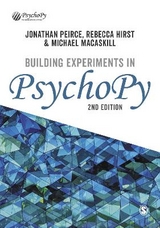
Building Experiments in PsychoPy
SAGE Publications Ltd (Verlag)
978-1-4739-9139-2 (ISBN)
PsychoPy is an open-source (free) software package for creating rich, dynamic experiments for psychology, neuroscience, and linguistics. It provides an intuitive graphical interface (the ‘Builder’) as well as the option to insert Python code. This combination makes it easy for teaching, but also flexible enough for all manner of behavioural experiments. Divided into three parts, this textbook is suitable for teaching practical undergraduate classes on research methods, or as a reference text for the professional scientist.
The book is written by Jonathan Peirce, the original creator of PsychoPy and Michael MacAskill, and they utilise their breadth of experience in Python development to educate students and researchers in this intuitive, yet powerful, experiment generation package.
Jonathan Peirce is Associate Professor in Psychology at the University of Nottingham, with a background in visual neuroscience and a particular interest in research methods. For his research, Jon needed precise (and dynamic) stimulus presentations. For teaching psychology undergraduates about research methods, he needed software that was intuitive enough for them to understand. The combination of these needs (and his generally geekiness) caused Jon gradually to create PsychoPy. Happily, many people have got on board with the project and it grew. When he isn’t designing experiments, writing software or trying to teach students to be awesome scientists, Jon can be found walking his dog, playing with his daughter or making unpleasant noises on a guitar. Michael MacAskill is a Senior Research Fellow in the Department of Medicine at the University of Otago, Christchurch. He is also the Research Director at the New Zealand Brain Research Institute. His training is in experimental psychology and his research is mainly in the field of Parkinson’s disease, through projects in brain imaging, neuropsychology, and epidemiology. His main joy, however, lies in measuring fast eye movements (saccades).Looking for better ways to study them, in 2008 he discovered what Jon had achieved with PsychoPy, and has since become a passionate believer in the enabling power of open-source software.Living in a geologically active area, Michael recently decided to move from a house perched on a cliff in a volcano to one situated in a very large lawn. In the weekends, he can be found mowing that lawn.
Chapter 1: Introduction
Section 1: For the beginner
Chapter 2: Building your first experiment
Chapter 3: Using images - a study into face perception
Chapter 4: Timing and brief stimuli: Posner cueing
Chapter 5: Creating dynamic stimuli (revealing text and moving stimuli)
Chapter 6: Providing feedback: simple Code Components
Chapter 7: Ratings: Measure the Big 5 personality constructs
Chapter 8: Randomization, blocks and counterbalancing: a bilingual
Chapter 9: Using the mouse for input: creating a visual search task li
Section 2: For the professional
Chapter 10: Implementing research designs with randomization
Chapter 11: Coordinates and color spaces
Chapter 12: Understanding your computer timing issues
Chapter 13: Monitors and Monitor Center
Chapter 14: Debugging Your Experiment
Chapter 15: Pro-tips, tricks, and lesser-known features
Section 3: For the specialist
Chapter 16: Psychophysics, stimuli and staircases
Chapter 17: Building an fMRI study
Chapter 18: Building an EEG study
Chapter 19: Add eye-tracking to your experiment
A: Mathematics refresher
B: Exercise solutions
| Erscheinungsdatum | 22.09.2018 |
|---|---|
| Verlagsort | London |
| Sprache | englisch |
| Maße | 170 x 242 mm |
| Gewicht | 540 g |
| Themenwelt | Geisteswissenschaften ► Psychologie ► Test in der Psychologie |
| ISBN-10 | 1-4739-9139-0 / 1473991390 |
| ISBN-13 | 978-1-4739-9139-2 / 9781473991392 |
| Zustand | Neuware |
| Haben Sie eine Frage zum Produkt? |
aus dem Bereich



